parking brake CADILLAC ELDORADO 1994 10.G Owners Manual
[x] Cancel search | Manufacturer: CADILLAC, Model Year: 1994, Model line: ELDORADO, Model: CADILLAC ELDORADO 1994 10.GPages: 398, PDF Size: 21.2 MB
Page 105 of 398
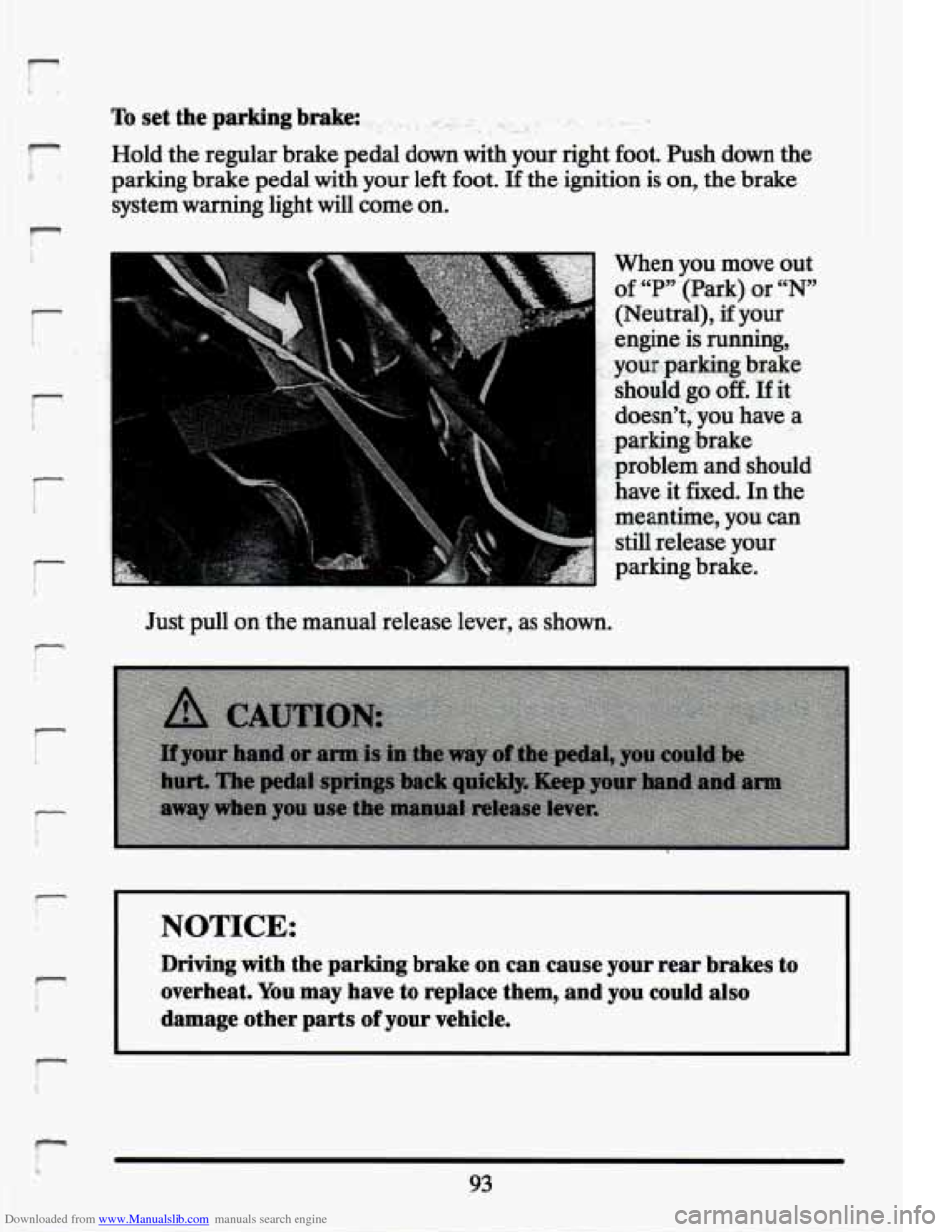
Downloaded from www.Manualslib.com manuals search engine i r
r
To set’ the parking brake: . .~ . ... I. . . ,-
Hold th,e regular brake pedal down with your right foot. Push down the
parking brake pedal with your left foot.
If the ignition .is on, the brake
system warning light will come on.
.- ” .
r
f- i
When you move out
of “P” (Park) or “N”
,.. (Neutral), if your
: engine is running,
,. your-parking brake
.:, should go off. If it
’ . doesn’t; ,you have a
,’: parking brake
.. problem and should
h\ave it fixed. In the
: meantime, you can
still release your
parking brake.
Just pull
on the manual release lever, as shown.
!
NOTICE:
Driving with-the parking brake on can cause your rear b,rakes to
overheat.
You may have to replace them, and you could also
damage other parts of your vehicle.
93
Page 106 of 398

Downloaded from www.Manualslib.com manuals search engine If you are towinr a trailer and are parking on any hill: See “Towing a
Trailer” in the Index. That section shows what to do first to keep the
trailer from moving.
SHIFTING INTO “P9’ (PARK)
Steering Column ShijZ Lever
1. Hold the brake pedal down with your right foot.
94
Page 107 of 398
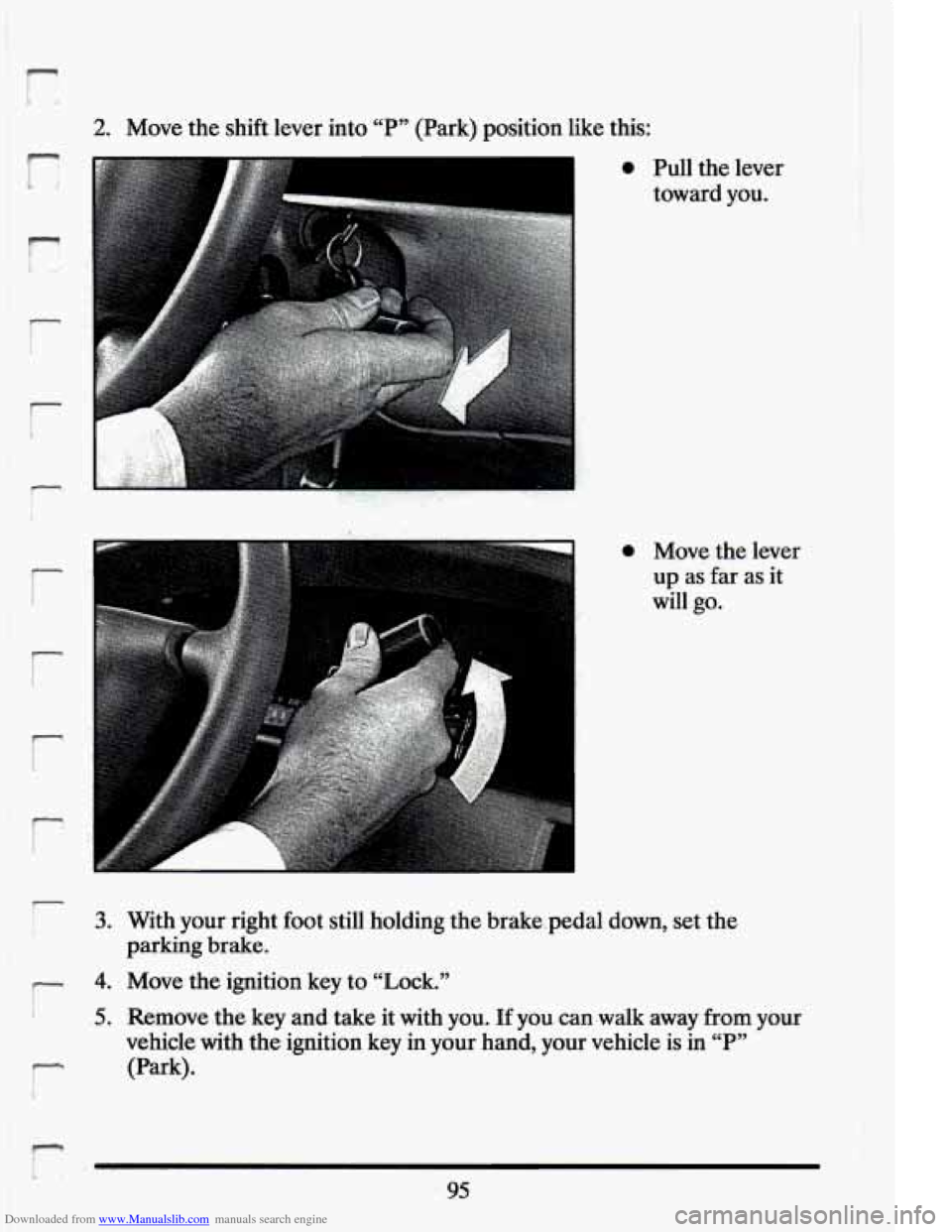
Downloaded from www.Manualslib.com manuals search engine r:
2. Move the shift lever into “P” (Park) position like this:
r.
r
0 Move the lever
up as far as it
will go.
0 Pull the lever
toward
you.
r--- 1 3. With your right foot still holding the brake.peda1 down, set the
parking brake.
4. Move the ignition key to “Lock.”
.5. Remove -the key and take it with you. If you camwalk away from your
vehicle with the-ignition key in your hand, your vehicle is in “P”
1 (Park).
i
-
95
Page 108 of 398

Downloaded from www.Manualslib.com manuals search engine Lonsole Shift Lever
1. Hold the brake pedal down with your right foot.
2. Move the shift lever into “P” (Park) position like this:
Hold in the
button on the
lever, and push
the lever all the
way toward the
front
of your
vehicle.
3. With your right foot still holding the brake pedal down, set the
parking brake.
4. Move the ignition key to “Lock.”
5. Remove the key and take it with you. If you can walk away from your
vehicle with the ignition key in your hand, your vehicle is in “P”
(Park).
-
L-
96
Page 109 of 398
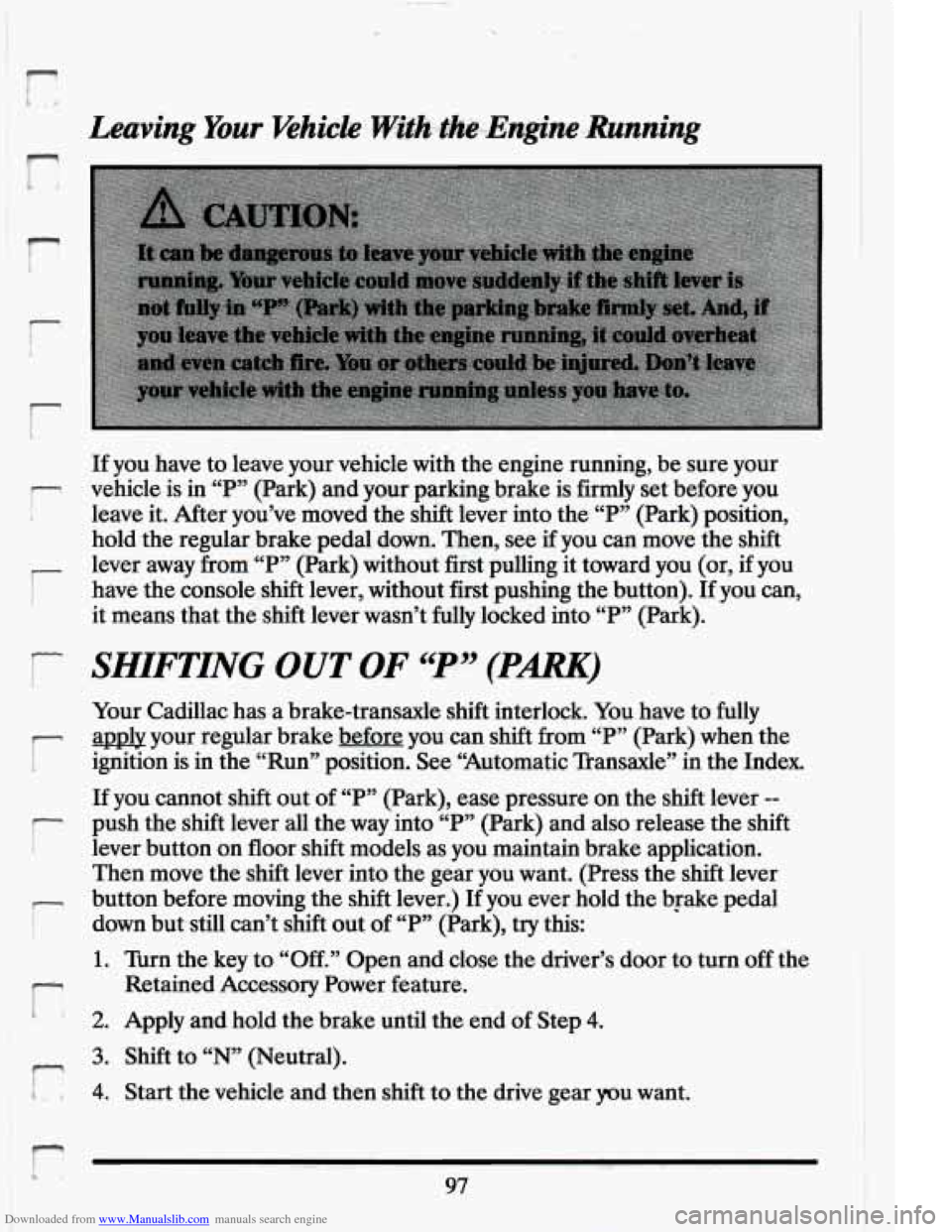
Downloaded from www.Manualslib.com manuals search engine r
i-
P
i 1
P
r
i
I?
P I i. 1
_... *- .*
If you have to leave your vehicle with the engine running, be sure your
vehicle is in “PYy (Park) and your parking brake is firmly set before you
leave it. After you’ve moved the shift lever into the “P” (Park) position,
hold the regular brake pedal down. Then, see if you can move the shift
lever away
from “P” (Park) without first pulling it toward you (or, if you
have the console shift
lever, without first pushing the button). If you can,
it means that the shift lever wasn’t fully locked into “P” (Park).
SHIFTING OUT OF “P” (PARK)
Your Cadillac has a brake-transaxle shift interlock. You have to fully
& your regular brake before you can shift from “P” (Park) when the
ignition is in the “Run” position. See “Automatic Transaxle” in the Index.
If you cannot shift out of “P” (Park), ease pressure on the shift lever --
push the shift lever all the way into “P” (Park) and also release the shift
lever button on floor shift models as you maintain brake application.
Then move the shift lever into the gear you want. (Press the shift lever
button before moving the shift lever.)
If you ever hold the brake pedal
down but still can’t shift out of “PYy (Park), try this:
1.
2.
3.
4.
Turn the key to “Off.” Open and close the driver’s door to turn off the
Retained Accessory Power feature.
Apply and hold the brake until the end of Step
4.
Shift to “N” (Neutral).
Start the vehicle and then shift to the drive gear you want.
i
Page 110 of 398

Downloaded from www.Manualslib.com manuals search engine Torque Lock
If you are parking on a hill and you don’t shift your transaxle into “P”
(Park) properly, the weight
of the vehicle may put too much force on the
parking pawl in the transaxle. You may find it difficult to pull the shift
lever out of “P” (Park). This is called “torque lock.”
To prevent torque
lock, set the parking brake and then shift into
“P” (Park) properly before
you leave the driver’s seat.
To find out how, see “Shifting Into ‘P’ (Park)”
in the Index.
If ‘?.orque lock” does occur, you may need to have another vehicle push
yours
a little uphill to take some of the pressure from the transaxle, so
you can pull the shift lever out of “P” (Park).
PARKING OKER THINGS TMTBURN
,,
-
98
Page 145 of 398
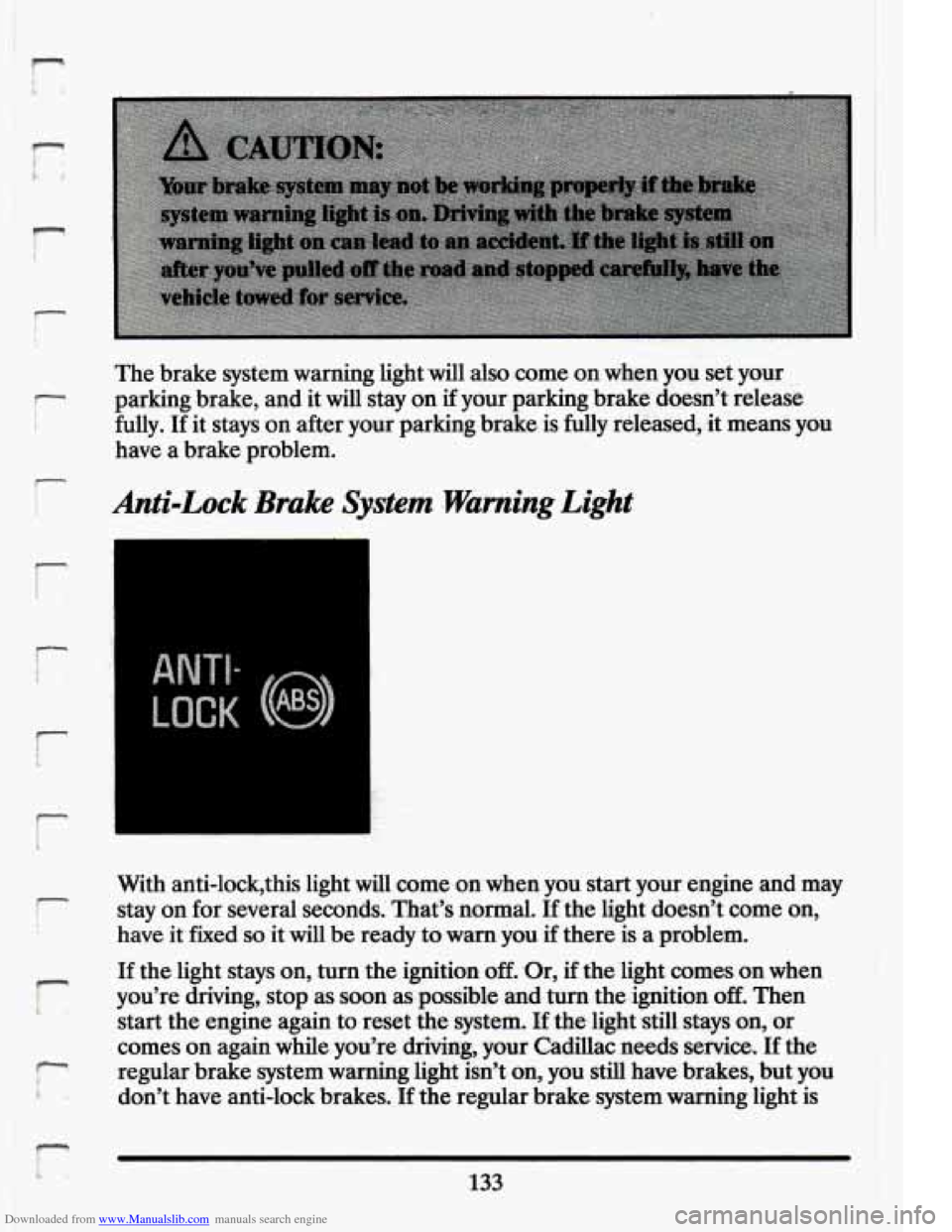
Downloaded from www.Manualslib.com manuals search engine ..
‘The brake system warning light will also.come on when you set your
parking ,brake, and it will stay on if your.:parking brake doesn’t release
fully. If
it stays on after your parking .brake is fully released, it means you
have a brake problem.
Anti-Lock 3rake System warning Light
LOCK
With anti-lock’this light will come on when you start your engine and may
stay on for several seconds. That’s normal. If the light doesn’t come
on,
have it fixed so it will be ready to warn you if there is a problem.
I-
i
If the light stays on, turn the ignition off. .Or, if the ‘light. comes on when
you’re driving, stop as soon as possible and turn the ignition
off. Then
start the engine again
to reset the system. If the-light still. stays on, or
comes on again while you’re driving, your Cadillac needs service.
If the
regular brake system warning
1ig.M isn’t. on, you still have brakes, but you
don’t have anti-lock brakes.
If the regular brake system warning light is
133
Page 218 of 398
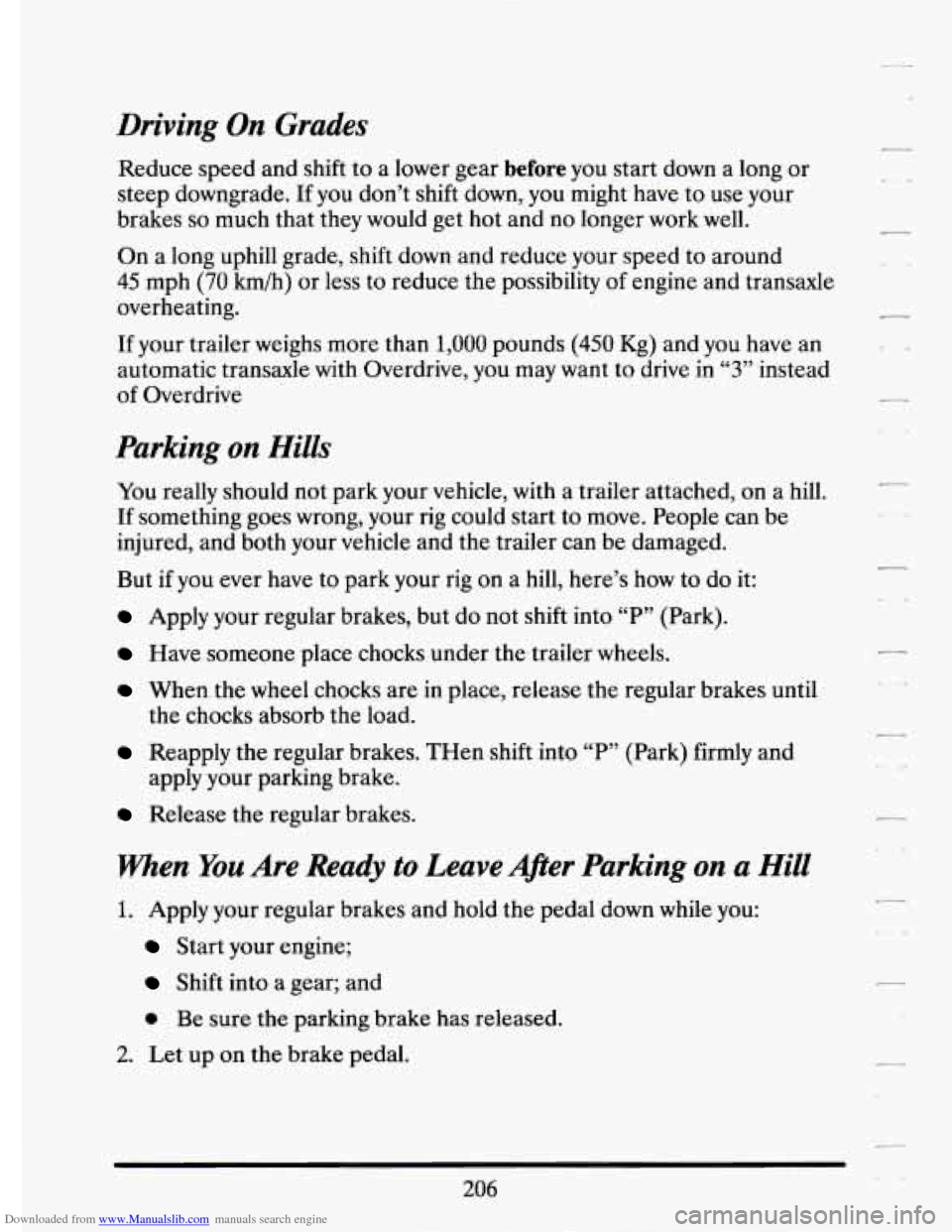
Downloaded from www.Manualslib.com manuals search engine Driving On Grades
Reduce speed and shift to a lower gear before you start down a long or
steep downgrade.
If you don’t shift down, you might have to use your
brakes
so much that they would get hot and no longer work well.
On a long uphill grade, shift down and reduce your speed to around
45 mph (70 km/h) or less to reduce the possibility of engine and transaxle
overheating.
If your trailer weighs more than 1,000 pounds (450 Kg) and you have an
automatic transaxle with Overdrive, you may want
to drive in “3” instead
of Overdrive
Parking on Hills
You really should not park your vehicle, with a trailer attached, \
on a hill.
If something goes wrong, your rig could start to move. People can be
injured, and both your vehicle and the trailer can be damaged.\
But
if you ever have to park your rig on a hill, here’s how to do it:
Apply your regular brakes, but do not shift into “P’, (Park).
Have someone place chocks-under the- trailer wheels.
When. the wheel chocks are in place, release the regular brakes until
the chocks absorb the load.
Reapply the regular brakes. THen shift into “P7, (Park) firmly and
apply your parking brake.
Release the regular brakes.
When You Are Ready to Leave Afler Parking on a Hill
1. Apply your regular brakes and hold the pedal down while you:
Start your engine;
Shift into a gear; and
0 Be sure the parking brake has released.
2. Let up on the brake pedal.
L
c
206
i
Page 230 of 398
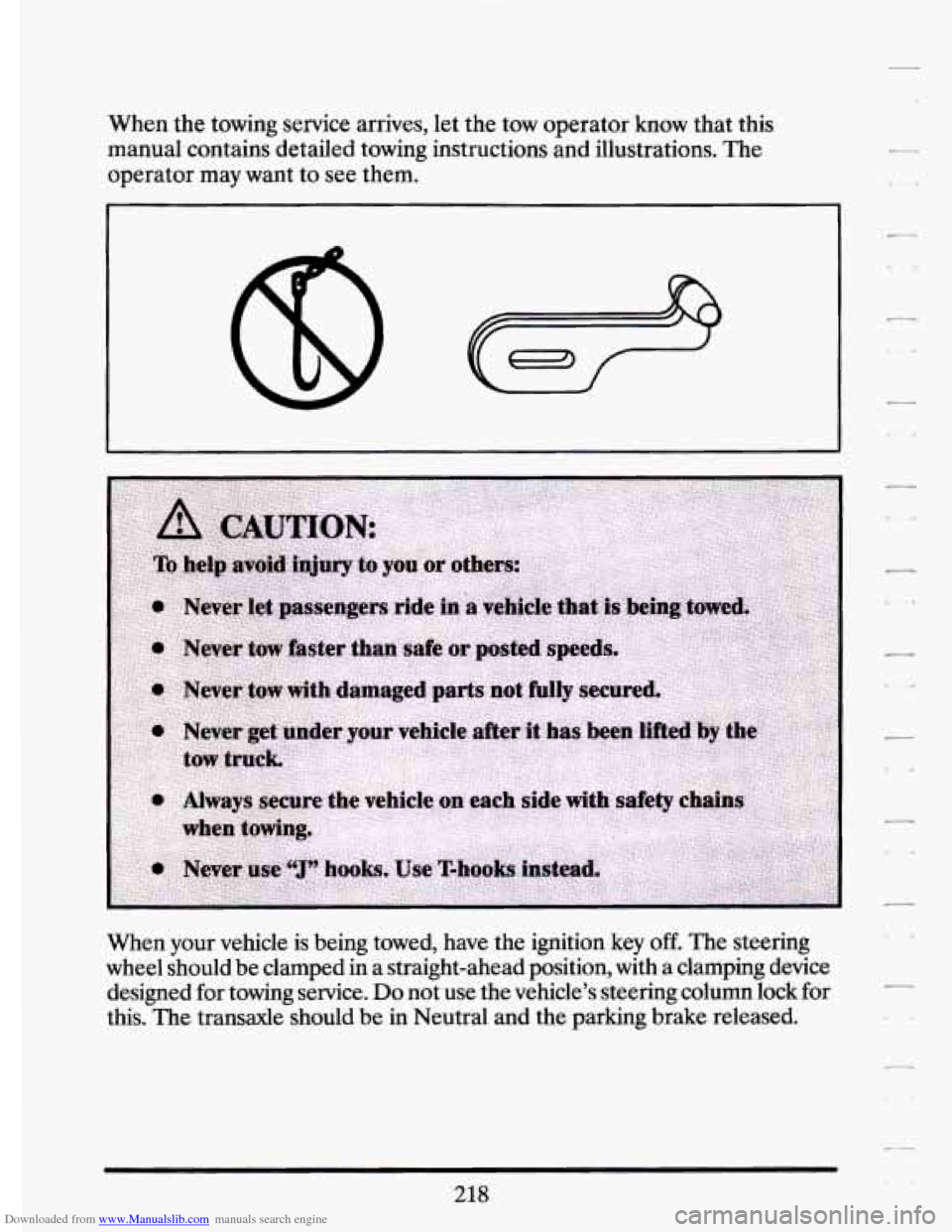
Downloaded from www.Manualslib.com manuals search engine When the towing service arrives, let the tow operator know that this
manual-contains detailed towing instructions and illustrations. The
operator may want to see them.
When your vehicle
is being towed, have the ignition key off. The steering
wheel should be clamped in a straight-ahead position, with
a clamping device
designed for towing service.
Do not use the vehicle’s steering column lock for
this. The transaxle should be in Neutral and the parking brake relea\
sed.
218
-.
Page 272 of 398
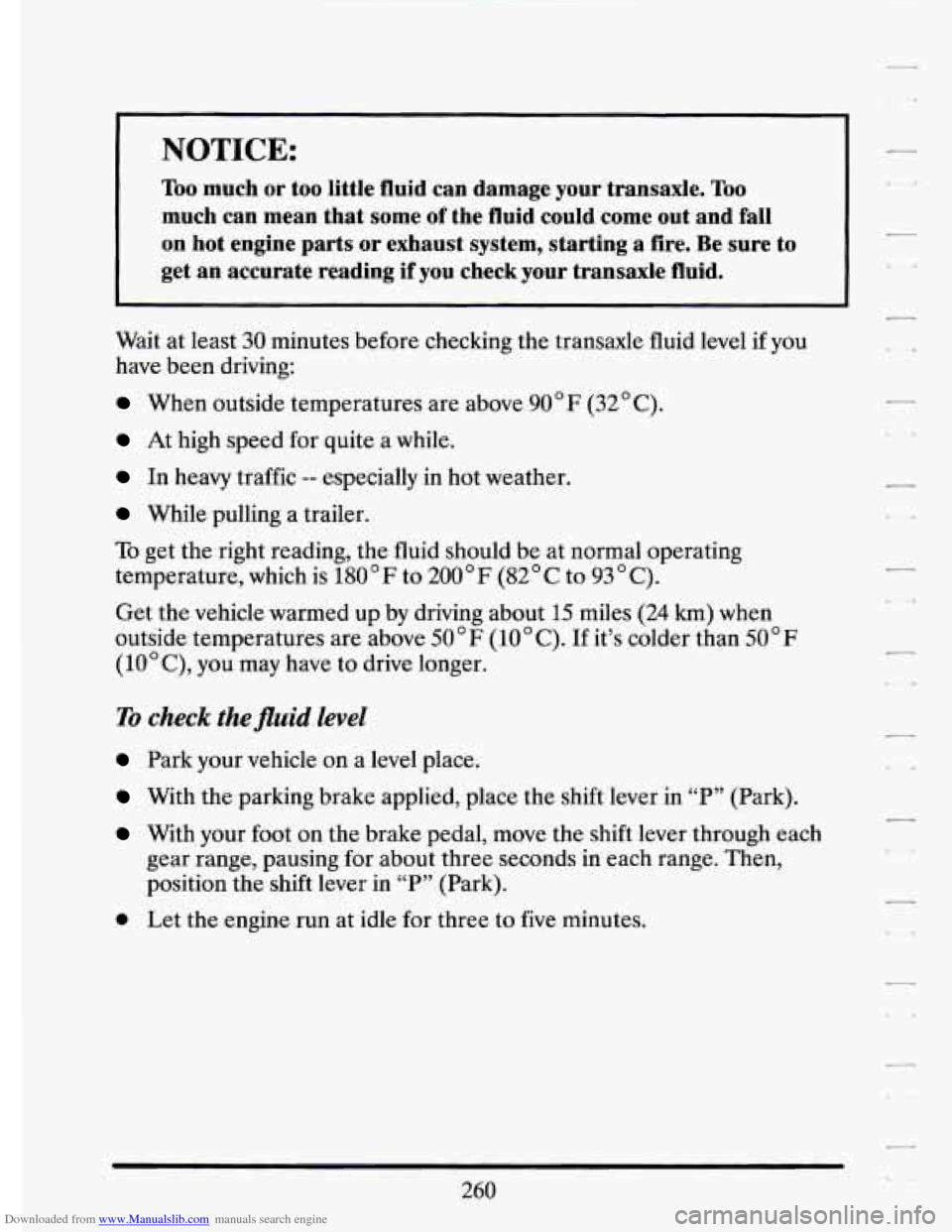
Downloaded from www.Manualslib.com manuals search engine NOTICE:
Too much or too little fluid can damage your transaxle. Too
much can mean that some of the fluid could come out and fall\
on hot engine parts or exhaust system, starting a fire.
Be sure to
get an accurate reading
if you check your transaxle fluid.
Wait at least 30 minutes before checking the transaxle fluid level if you
have been driving:
When outside temperatures are above 90'F (32" C).
At high speed for quite a while.
In heavy traffic -- especially in hot weather.
While pulling a trailer.
To get the right reading, the fluid should be at normal operating
temperature, which is
180 F to 200 ' F (82' C to 93 C).
Get the vehicle warmed up by driving about 15 miles (24 km) when
outside temperatures are above
50 "F (10'C). If it's colder than 50'F
(lO'C), you may have to drive longer.
To check the fluid level
Park your vehicle on a level place.
With the parking brake applied, place the shift lever in "P" (Park).
With your foot on the brake pedal, move the shift lever through each
gear range, pausing for about three seconds in each range. Then,
position the shift lever in
"P" (Park).
0 Let the engine run at idle for three to five minutes.
260